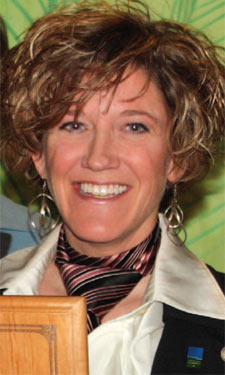 Beth Miller is director of Marketing and Public Information for Five Rivers MetroParks in Dayton, Ohio. When NRPA’s Conservation Task Force (CTF) went to work in 2010 researching outstanding examples of conservation leadership from park departments across the nation, Miller stepped forward to serve on the stewardship committee. Though she does not have a background in conservation sciences or parks and recreation, her main goal was, she says, “to learn more about how marketing and conservation can work together more effectively and have a larger impact on mission-based communications.” Miller approached the CTF work energetically—and describes her volunteer work as an illuminating experience of working with a wide variety of experts “toward a common vision of elevated conservation awareness.”
Beth Miller is director of Marketing and Public Information for Five Rivers MetroParks in Dayton, Ohio. When NRPA’s Conservation Task Force (CTF) went to work in 2010 researching outstanding examples of conservation leadership from park departments across the nation, Miller stepped forward to serve on the stewardship committee. Though she does not have a background in conservation sciences or parks and recreation, her main goal was, she says, “to learn more about how marketing and conservation can work together more effectively and have a larger impact on mission-based communications.” Miller approached the CTF work energetically—and describes her volunteer work as an illuminating experience of working with a wide variety of experts “toward a common vision of elevated conservation awareness.”
In documenting the conservation efforts of Five Rivers MetroParks, what did you find most motivating?
The most motivating component for me was the opportunity to advocate for and lead discussions about the critical nature (no pun intended) of a strong communication strategy as a part of any conservation plan. At Five Rivers MetroParks, we had witnessed the success of those efforts (see metroparks.org/forests) and wanted to take the conversation to the Conservation Task Force to see if it would translate from the local level to the national level.
While I knew that many parks had not had the opportunity to invest in proactive, collaborative, strategic marketing plans, I found that the critical ingredient of “established need” was universally present for all park districts across the country. Very few, however, planned to prioritize communications with the public about their efforts. There is a humility in the parks and recreation industry which is admirable but, ultimately, damaging. We can protect habitat, but the conservation of the land is not enough if advocacy marketing is not part of the plan.
It may be our job as an agency to protect the land—but it is also our responsibility as a community to advocate through messaging and empowerment for the protection of the land. We have to provide a solid vision of success, identify our partners in the community, talk to target audiences who will be early adopters of conservation-oriented viewpoints, and communicate that message in relevant and compelling ways. We must have clear, measurable objectives based upon solid goals—and we must execute strong, feasible strategies.
What advice would you offer to your fellow NRPA members who might want to take some leadership in conservation efforts in their agencies but don’t know where to begin?
Just as everyone in your community can contribute to your agency’s conservation efforts, everyone in the NRPA community can contribute to the conservation efforts of our industry. I would encourage all NRPA members to…well, advocate for advocacy! Invest in a solid marketing strategy. Gather best practices from each other. Use NRPA’s collaborative tools to learn what you can from stellar industry leaders. Then, find your own compelling story that is aligned with your mission. Be true to the vision, the mission, and the message.
A commitment to that vision will help the public become better stewards of our land. That grassroots style of stewardship will probably evolve in ways that we haven’t stopped to think about in the past—but in ways I suspect will also be the key to a better future for conservation.
Become more involved. Become part of that future.

